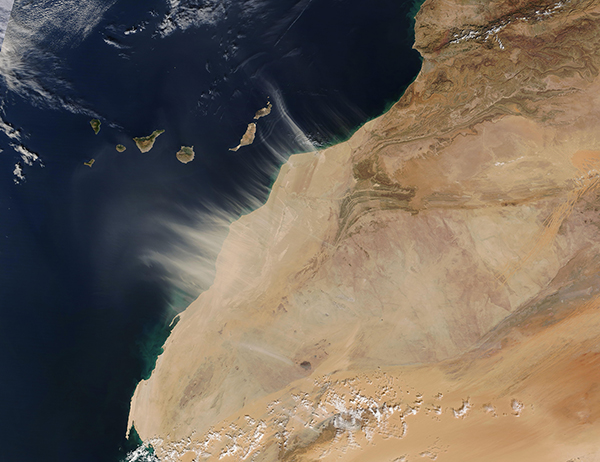Images
January 18, 2022 - Dust off Western Sahara
Tweet
Strong winds carried streamers off dust off of Western Sahara in mid-January 2022. The Moderate Resolution Imaging Spectroradiometer (MODIS) on board NASA’s Terra satellite acquired a true-color image of the halo-like effect created by the camel-colored dust on January 14. At that time, most of the streamers of dust appeared to be rising from multiple point sources not far inland and moving to the northwest, towards the Canary Islands.
A dusty haze further inland suggests additional dust moving from the sands of the Sahara Desert, not just the coastal region. In fact, a dense cloud of dust was also moving over Algeria, more than 990 miles (1,600 km) away from the coastal plumes. This interior cloud of dust is not visible, as it sits well to the northeast and outside the edges of the image.
The dust storm, which began on January 14, continued to pump dust from the Sahara Desert over the coast and into the atmosphere over the Atlantic Ocean. By January 16, the western Canary Islands were shrouded under a heavy cloud of dust. Dust also appeared to have become entrained with a layer of cloud and was moving like a tan river northward over the blue waters of the Atlantic where it extending as far north as Portugal.
Multi-day dust storms are common in this region, with the Sahara Desert producing a steady and bountiful supply of dust. Such storms can occur at any time of the year and dust from the Sahara may cross the Atlantic to reach the islands in the Caribbean, where it proves a mixed blessing. Extremely heavy doses of dust can damage coral reefs, but the mineral-and-nutrient rich dust can improve soils and feed marine life, such as the microscopic, plant-like organisms (phytoplankton) which serve as the base of the marine food web.
Image Facts
Satellite:
Terra
Date Acquired: 1/4/2022
Resolutions:
1km (1.3 MB), 500m (3.6 MB), 250m (2.1 MB)
Bands Used: 1,4,3
Image Credit:
MODIS Land Rapid Response Team, NASA GSFC
Tweet
Strong winds carried streamers off dust off of Western Sahara in mid-January 2022. The Moderate Resolution Imaging Spectroradiometer (MODIS) on board NASA’s Terra satellite acquired a true-color image of the halo-like effect created by the camel-colored dust on January 14. At that time, most of the streamers of dust appeared to be rising from multiple point sources not far inland and moving to the northwest, towards the Canary Islands.
A dusty haze further inland suggests additional dust moving from the sands of the Sahara Desert, not just the coastal region. In fact, a dense cloud of dust was also moving over Algeria, more than 990 miles (1,600 km) away from the coastal plumes. This interior cloud of dust is not visible, as it sits well to the northeast and outside the edges of the image.
The dust storm, which began on January 14, continued to pump dust from the Sahara Desert over the coast and into the atmosphere over the Atlantic Ocean. By January 16, the western Canary Islands were shrouded under a heavy cloud of dust. Dust also appeared to have become entrained with a layer of cloud and was moving like a tan river northward over the blue waters of the Atlantic where it extending as far north as Portugal.
Multi-day dust storms are common in this region, with the Sahara Desert producing a steady and bountiful supply of dust. Such storms can occur at any time of the year and dust from the Sahara may cross the Atlantic to reach the islands in the Caribbean, where it proves a mixed blessing. Extremely heavy doses of dust can damage coral reefs, but the mineral-and-nutrient rich dust can improve soils and feed marine life, such as the microscopic, plant-like organisms (phytoplankton) which serve as the base of the marine food web.
Image Facts
Satellite:
Terra
Date Acquired: 1/4/2022
Resolutions:
1km (1.3 MB), 500m (3.6 MB), 250m (2.1 MB)
Bands Used: 1,4,3
Image Credit:
MODIS Land Rapid Response Team, NASA GSFC




